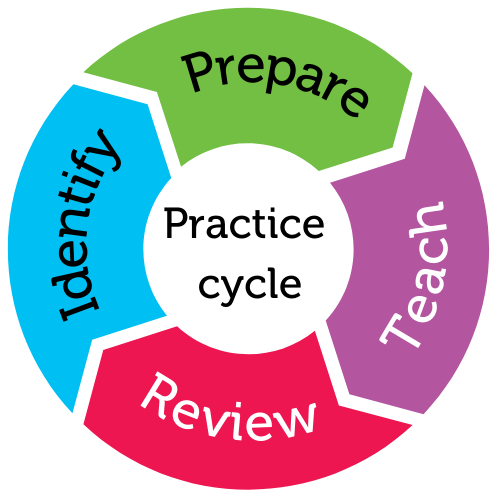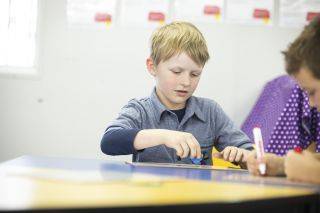
For student year
Helps students to
- feel safe and secure
- meet behavioural expectations
Helps teachers to
- keep students on-task
- know their students
Summary
Active supervision has been shown to improve classroom behaviour and engagement, providing students with immediate opportunities for feedback. It provides an opportunity to build relationships and acknowledge student behaviour.
By actively supervising your classroom, you will:
- encourage students to follow class rules and routines
- help students to remain focused on the task at hand
- provide a safe and secure learning environment.
How this practice works
Watch this video for more information about active supervision.
Duration 2:56
Australian Professional Standards for Teachers related to this practice
3.5 – Use effective communication
4.3 - manage challenging behaviour
For further information, see Australian Professional Standards for Teachers AITSL page
Preparing to teach
What is active supervision?
Active supervision is defined by three behaviours – scanning, moving and interacting.
- Scanning involves frequently examining the room, looking for where instruction and feedback are most necessary.
- Moving involves walking around the room, making one’s presence known to students, and offering suggestions and assistance.
- Interacting involves building positive relationships with students, having informal conversations and reinforcing appropriate behaviours
Active supervision provides teachers with valuable information about how students are responding to an activity, or to classroom instruction. It helps promote a positive, safe, and supportive learning environment which, in turn, has a positive influence on student learning and facilitates inclusion.
Plan to actively supervise students…
- while teaching
- when transitioning
- in non-classroom environments.
How does it work?
Active supervision provides teachers with valuable information about how students are responding to an activity or to classroom instruction. It also promotes student safety and wellbeing in schools in a range of environments, including common areas.
Within the classroom, active student supervision involves moving around the room, interacting with students regularly, providing feedback (praise and correction), scanning for off-task behaviour, and using teacher proximity to prompt appropriate behaviour. An alternative to the teacher moving around is the setting up of tutor or check-in stations, where all students approach the teacher for a review of their work. This is a valuable opportunity for direct instruction and has the additional benefit of providing students with a sensory-motor or movement break.
It is important to organise the learning environment in such a way that the teacher can visually scan and move throughout all areas of the room.
Active supervision takes advantage of all available learning opportunities and ensures students are never unattended.
How do I do it?
- Scan - the teacher examines the environment frequently and notices appropriate and inappropriate behaviours, and provides feedback on these;
- Move - the teacher moves around the classroom or other setting, or the students move to the teacher for 1:1 support;
- Interact - the teacher elicits conversations with students, offers help and reminders to students, and provides positive reinforcers
Review and reflect on your direct student supervision time commitment and style to identify occasions during each day’s routines when more active monitoring and interaction with students would be beneficial. For example, close observation and feedback are essential during busy, noisy group work sessions or during less-preferred activities when students are at risk of distraction and/or task avoidance.
- Plan an active supervision routine that is targeted and consistent.
- Organise the learning environment in such a way that you can visually scan and move throughout all areas of the room.
- Address all aspects of student safety and wellbeing.
- Ensure that class rules and other visual support materials are in place.
- Create and provide reinforcing student safety and wellbeing resources, for example as part of classroom rules & other visual strategies.
It works better if:
- positive contacts are kept simple, e.g., “Good afternoon, Jeremy. It’s nice to see you.”; friendly reminders help students to get it right before they do something wrong
- communication is positive, caring and respectful
- for students who are reluctant to draw attention to themselves in front of their peers, have an agreed way that students can signal a request for help, such as holding a hand to the chest or placing a card with a question mark on the desk.
It doesn’t work if:
- inappropriate behaviours are noticed and commented on more often than appropriate behaviours
- active supervision draws negative attention to students who are experiencing difficulties
- active supervision is applied inconsistently.
In the classroom
How will I know if it’s working?
- There is a positive impact on student behavior
- There is an increase in student engagement
- Students feel safe and secure within the learning environment.
Notes on active supervision
- Move around the learning environment observing how students respond to:
- the activity
- classroom instruction.
- Interact with students giving prompts and feedback (encouragement, praise, and correction).
- Visually scan the environment for on- and off-task behaviour.
- Respond consistently, effectively, and quickly to student behaviour and requests for help.
- Use teacher proximity to prompt appropriate behaviour.
- Take advantage of all available learning opportunities.
- Ensure students are never unattended.
- Ensure appropriate behaviours are commented on.
- Avoid drawing attention to students who are experiencing difficulties.
Practice toolkit
Practice implementation planner template
We know it's not always easy to keep track of what's working and what isn't. So, we've created this template for you to record and reflect on what you're doing to create more inclusive classrooms. The implementation planner contains:
- guidance around goal setting
- a reflection section (what worked, didn’t work, what to change, and next steps)
- prompting questions.
Implementation planner with examples
Set your professional learning goal for:
Actively supervise your class
Benefits of goal setting
Setting, working towards, and reflecting on goals helps you grow professionally and improve your practice. You can access AITSL learning resources for teachers to learn more about:How to set goals
The Australian Institute for Teaching and School Leadership recommends using the SMART matrix to frame your goal setting.SMART goals refers to goals that are:
- Specific
- Measurable
- Achievable
- Relevant
- Time-phased
Resources
Actively supervise your class - Practice Brief
Related Practices

Interact with every student
TEACHING PRACTICE
For student years
Helps students to
- feel valued
- engage in interactions
This practice is from the core research project
Learning Cycle

